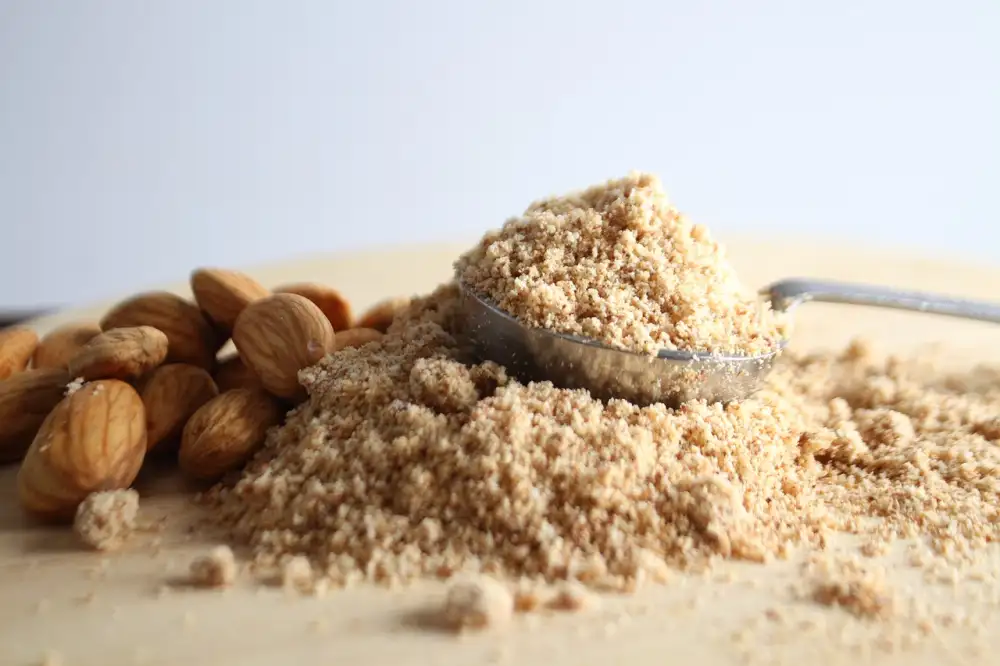Master the Art of Making Almond Flour: A Step-by-Step Guide for Food Enthusiasts

Almond flour, also known as almond meal, is a versatile ingredient that has gained popularity in the culinary world. Made from finely ground almonds, it offers a delicious and nutritious alternative to traditional wheat flour. Almond flour is gluten-free, making it suitable for those with gluten sensitivities or dietary restrictions. It adds a rich nutty flavor and moist texture to baked goods such as cookies, cakes, and breads. Additionally, almond flour can be used as a coating for meats or vegetables, adding a crunchy and flavorful element to dishes. Whether you're a seasoned chef or an aspiring home cook, mastering the art of making almond flour at home opens up endless possibilities in your culinary journey.
Step-by-step guide on making almond flour at home
a. Selecting high-quality almonds: Start by choosing fresh, raw almonds that are free from any mold or rancid smell. Opt for organic almonds if possible, as they are grown without the use of harmful pesticides.
b. Blanching and peeling the almonds: Bring a pot of water to a boil and add the almonds. Let them boil for about 1-2 minutes, then drain and rinse them with cold water. Gently squeeze each almond between your fingers to remove the skin.
c. Drying the almonds thoroughly: Spread the blanched almonds on a clean kitchen towel or paper towels and let them air dry for a few hours or overnight. Make sure they are completely dry before proceeding to the next step.
d. Grinding the almonds into a fine powder: Transfer the dried almonds to a food processor or blender and pulse until you achieve a fine, powdery consistency. Be careful not to over-process, as this may result in almond butter instead of flour.
By following these simple steps, you can easily make your own almond flour at home. It's a cost-effective alternative to store-bought options and allows you to have full control over the quality of your ingredients.
Selecting high-quality almonds
When it comes to making almond flour at home, selecting high-quality almonds is crucial. Look for almonds that are fresh and have a sweet aroma. Avoid almonds that have a rancid smell or appear discolored. Opt for organic almonds if possible, as they are free from pesticides and other chemicals. Additionally, choose almonds that are whole and unbroken to ensure the best results. By starting with high-quality almonds, you can guarantee a superior almond flour that will elevate your culinary creations.
Blanching and peeling the almonds
Blanching and peeling the almonds is an essential step in making homemade almond flour. This process helps to remove the skins, resulting in a smoother texture and milder flavor. To blanch the almonds, start by bringing a pot of water to a boil. Once boiling, add the almonds and let them cook for about 1 minute. Then, drain the almonds and rinse them under cold water to cool them down. To peel the almonds, simply apply gentle pressure with your fingers or use a small knife to slide off the skins. It's important to ensure that all the skins are removed before proceeding to the next step.
Drying the almonds thoroughly
After blanching and peeling the almonds, it is important to ensure that they are thoroughly dried before grinding them into flour. Excess moisture can affect the texture and shelf life of the almond flour. To dry the almonds, spread them out in a single layer on a clean kitchen towel or baking sheet. Allow them to air dry for at least 24 hours or until completely dry to the touch. You can also place them in a low-temperature oven (around 150°F/65°C) for about 1-2 hours to speed up the drying process. Make sure to check on them periodically to prevent burning. Once the almonds are completely dry, they are ready to be ground into a fine powder.
Grinding the almonds into a fine powder
Grinding the almonds into a fine powder is the crucial step in making almond flour. Once the almonds are dry, transfer them to a food processor or high-powered blender. Start by pulsing the almonds a few times to break them down into smaller pieces. Then, blend continuously until you achieve a fine, powdery consistency. Be patient during this process as it may take several minutes for the almonds to reach the desired texture. Avoid over-blending, as this can lead to almond butter rather than flour. Stop occasionally to scrape down the sides of the container and ensure even grinding. Once you have achieved a fine powder, sift it through a fine-mesh sieve to remove any larger pieces that didn't grind properly. Your homemade almond flour is now ready to be used in your favorite recipes!
Tips for storing homemade almond flour
Tips for Storing Homemade Almond Flour:
1. Use airtight containers: To keep your homemade almond flour fresh and free from moisture, store it in airtight containers such as glass jars or plastic bags with zip locks.
2. Keep it in a cool, dark place: Almond flour can turn rancid if exposed to heat and light. Store it in a cool, dark pantry or refrigerator to extend its shelf life.
3. Label and date the container: It's important to label your almond flour container with the date of preparation. This will help you keep track of its freshness and ensure you use it within a reasonable time frame.
4. Avoid storing near strong odors: Almond flour has a delicate flavor that can easily absorb strong odors from other foods. Keep it away from spices, onions, garlic, or any other strongly scented ingredients.
5. Freeze for long-term storage: If you don't plan on using your almond flour within a few months, consider freezing it. Place the almond flour in an airtight freezer bag or container and store it in the freezer for up to 6 months.
By following these tips, you can ensure that your homemade almond flour stays fresh and ready to use whenever you need it in your culinary creations.
Exploring the benefits of using almond flour in recipes
Almond flour is not only a versatile ingredient but also offers numerous health benefits. It is gluten-free, making it an excellent alternative for those with gluten sensitivities or celiac disease. Additionally, almond flour is low in carbohydrates and high in healthy fats, fiber, and protein. This combination helps to regulate blood sugar levels and promote satiety, making it a great option for those looking to manage their weight or control their appetite. Moreover, almond flour adds a rich nutty flavor and moist texture to baked goods, enhancing the overall taste experience. With its nutritional profile and culinary advantages, incorporating almond flour into your recipes can elevate them to new heights of taste and healthiness.
In conclusion, mastering the art of making almond flour at home opens up a world of culinary possibilities. By following the step-by-step guide outlined above, you can create your own high-quality almond flour that is free from additives and preservatives.
Not only is homemade almond flour more cost-effective, but it also allows you to have complete control over the process. You can select the best almonds, blanch and peel them to perfection, and grind them into a fine powder.
By storing your homemade almond flour in an airtight container in a cool, dry place, you can ensure its freshness and extend its shelf life. Remember to label the container with the date of preparation for reference.
Using almond flour in your recipes brings numerous benefits. It adds a delicate nutty flavor and a moist texture to baked goods. It is also gluten-free and low in carbohydrates, making it an excellent alternative for those with dietary restrictions or seeking healthier options.
So why not embark on this culinary adventure and start making your own almond flour at home? With practice and experimentation, you will soon discover the endless possibilities it offers in enhancing the artistry of food.
Published: 29. 11. 2023
Category: Food



